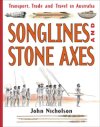Review:

 Allen
and Unwin, 2007
Allen
and Unwin, 2007
This 32 page non fiction book, the first in a series, tells of the incredible trade networks set up across Australia by the Aboriginal Peoples. The Dieri people of Central Australia, for example, traded pitjuri (the leaves of a small shrub which were used as a stimulant, and to ward off hunger and tiredness) to people in Northern Queensland, and to the Coorong and Victoria exchanging the drug for stone implements, possum skins and ochre.
The book is divided into 5 chapters, each retelling part of the story. The first chapter outlines 60,000 years of Aboriginal history, giving an all too brief dip into the past, but giving a background against which the rest of the book is set. Chapter 2 gives information about how the Aboriginal Peoples moved about the land and chapter 3 turns to the point of the book; the networks set up by which these people traded. It is this chapter which is the most interesting, outlining ways in which goods were traded and what goods were traded. Chapter 4 gives the reader a lot of information about the markets to which many hundreds of people would come to exchange their goods. Again, lists of goods to be traded are given. Chapter 5 completes the text giving an outline of overseas trade which occurred before European invasion. And the last pages tells us of the changes made when the Europeans first arrived, and oddly, then recounts the diseases brought by the new settlers.
This book is a most useful resource for school libraries. The information provided in this book is very sketchily dealt with in texts up to now, and the book provides a mass of information usually hard to find. Students will need help in accessing some of the information they need however, because there are few clues to guide them. The index is brief, and there are no highlighted words, information boxes or minor headings. The pictures and maps are excellent, but one of the most informative maps is across the middle of two pages, making it difficult to read (pages 16 and 17)
But these quibbles aside, the book is a most useful addition to any school library and will be well used by the astute teacher.
Fran Knight
Songlines and Stone Axes: Transport, Trade and Travel in Australia by John Nicholson

 Allen
and Unwin, 2007
Allen
and Unwin, 2007This 32 page non fiction book, the first in a series, tells of the incredible trade networks set up across Australia by the Aboriginal Peoples. The Dieri people of Central Australia, for example, traded pitjuri (the leaves of a small shrub which were used as a stimulant, and to ward off hunger and tiredness) to people in Northern Queensland, and to the Coorong and Victoria exchanging the drug for stone implements, possum skins and ochre.
The book is divided into 5 chapters, each retelling part of the story. The first chapter outlines 60,000 years of Aboriginal history, giving an all too brief dip into the past, but giving a background against which the rest of the book is set. Chapter 2 gives information about how the Aboriginal Peoples moved about the land and chapter 3 turns to the point of the book; the networks set up by which these people traded. It is this chapter which is the most interesting, outlining ways in which goods were traded and what goods were traded. Chapter 4 gives the reader a lot of information about the markets to which many hundreds of people would come to exchange their goods. Again, lists of goods to be traded are given. Chapter 5 completes the text giving an outline of overseas trade which occurred before European invasion. And the last pages tells us of the changes made when the Europeans first arrived, and oddly, then recounts the diseases brought by the new settlers.
This book is a most useful resource for school libraries. The information provided in this book is very sketchily dealt with in texts up to now, and the book provides a mass of information usually hard to find. Students will need help in accessing some of the information they need however, because there are few clues to guide them. The index is brief, and there are no highlighted words, information boxes or minor headings. The pictures and maps are excellent, but one of the most informative maps is across the middle of two pages, making it difficult to read (pages 16 and 17)
But these quibbles aside, the book is a most useful addition to any school library and will be well used by the astute teacher.
Fran Knight
© Pledger
Consulting, 2007